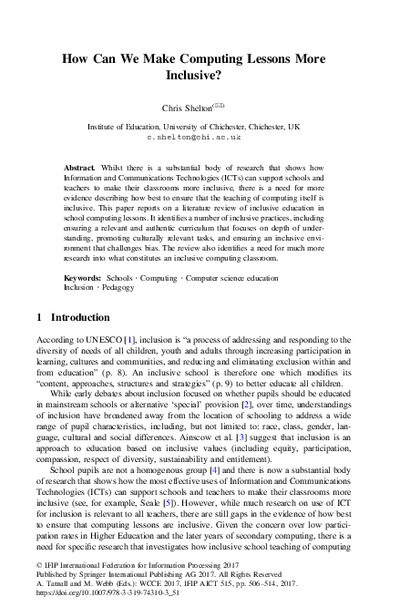How Can We Make Computing Lessons More Inclusive? Development of an Instrument and First Results
Chris Shelton
Zu finden in: Tomorrow's Learning: Involving Everyone. Learning with and about Technologies and Computing (Seite 506 bis 514), 2017
  |
 |
 Diese Seite wurde seit 1 Jahr inhaltlich nicht mehr aktualisiert.
Unter Umständen ist sie nicht mehr aktuell.
Diese Seite wurde seit 1 Jahr inhaltlich nicht mehr aktualisiert.
Unter Umständen ist sie nicht mehr aktuell.
 Zusammenfassungen
Zusammenfassungen
 Whilst there is a substantial body of research that shows how Information and Communications Technologies (ICTs) can support schools and teachers to make their classrooms more inclusive, there is a need for more evidence describing how best to ensure that the teaching of computing itself is inclusive. This paper reports on a literature review of inclusive education in school computing lessons. It identifies a number of inclusive practices, including ensuring a relevant and authentic curriculum that focuses on depth of understanding, promoting culturally relevant tasks, and ensuring an inclusive environment that challenges bias. The review also identifies a need for much more research into what constitutes an inclusive computing classroom.
Whilst there is a substantial body of research that shows how Information and Communications Technologies (ICTs) can support schools and teachers to make their classrooms more inclusive, there is a need for more evidence describing how best to ensure that the teaching of computing itself is inclusive. This paper reports on a literature review of inclusive education in school computing lessons. It identifies a number of inclusive practices, including ensuring a relevant and authentic curriculum that focuses on depth of understanding, promoting culturally relevant tasks, and ensuring an inclusive environment that challenges bias. The review also identifies a need for much more research into what constitutes an inclusive computing classroom. Dieses Kapitel erwähnt ...
Dieses Kapitel erwähnt ...
 Personen KB IB clear | Catherine Ashcraft , Quinn Burke , Yasmin B. Kafai , Michelle Lasen , Stephanie Ludi , Thomas Reichlmayr , Linda Sandvik , Neil Smith , Clare Sutcliffe , Jeannette M. Wing | |||||||||||||||||||||||||||||||||||||||||||||||||||||||||||||||
 Begriffe KB IB clear | kulturelles Kapital | |||||||||||||||||||||||||||||||||||||||||||||||||||||||||||||||
 Bücher |
| |||||||||||||||||||||||||||||||||||||||||||||||||||||||||||||||
 Texte |
|
 Zitationsgraph
Zitationsgraph
 Zitationsgraph (Beta-Test mit vis.js)
Zitationsgraph (Beta-Test mit vis.js)
 Zeitleiste
Zeitleiste
 Anderswo finden
Anderswo finden
 Volltext dieses Dokuments
Volltext dieses Dokuments
 |  How Can We Make Computing Lessons More Inclusive?: Artikel als Volltext bei Springerlink ( How Can We Make Computing Lessons More Inclusive?: Artikel als Volltext bei Springerlink ( : :  , 119 kByte; , 119 kByte;  : :  ) ) |
 Anderswo suchen
Anderswo suchen 
 Beat und dieses Kapitel
Beat und dieses Kapitel
Beat hat Dieses Kapitel während seiner Zeit am Institut für Medien und Schule (IMS) ins Biblionetz aufgenommen. Beat besitzt kein physisches, aber ein digitales Exemplar. Eine digitale Version ist auf dem Internet verfügbar (s.o.). Aufgrund der wenigen Einträge im Biblionetz scheint er es nicht wirklich gelesen zu haben. Es gibt bisher auch nur wenige Objekte im Biblionetz, die dieses Werk zitieren.
















 Biblionetz-History
Biblionetz-History